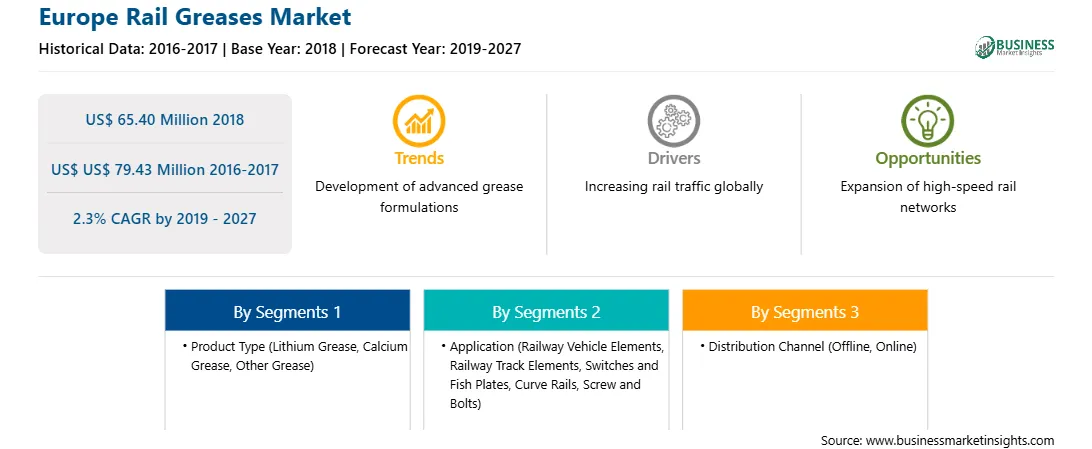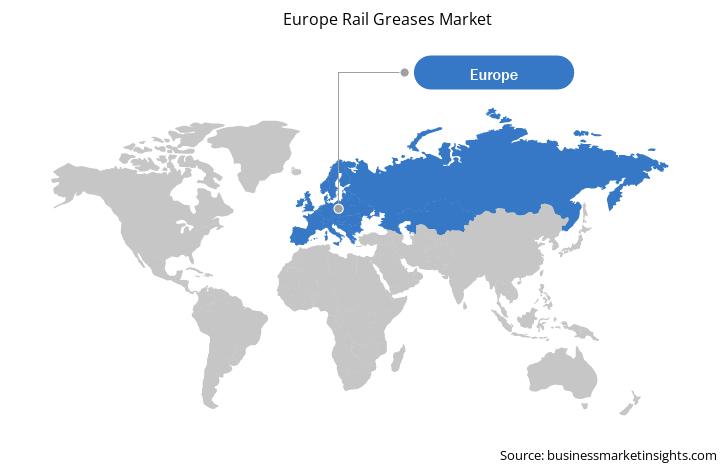Grease is a solid or semi-solid lubricating oil. Greases contain additional lubricating particles, such as molybdenum disulfide, graphite, or polytetrafluoroethylene (PTFE). Different types of greases combine the lubricating properties of oils with added stickiness, which allows the lubricant to adhere to the surfaces better. Grease possesses characteristic feature such as high initial viscosity, which make it frictional. It is popularly used across various industries such as automobile, railway, construction, pharmaceutical, food & beverage, mining and numerous others. For rails, greases can be used in mechanisms where lubrication is required frequently and where a lubricating oil does not stay for long. Grease acts as a sealant to avert ingress of water and incompressible materials. Grease is also being used for maintenance of various rail elements such as railway axles & wheels, bearings & chains, brake elements, interior components, pantographs and railway track components, as it prevents entry of contaminants or loss of lubricant. Soft grease used in gearboxes, for noise reduction, as leakage resistant, and for suspension of solid additives. Greased components consumes a small amount of power and is an even less vulnerable impact to any wear tear damage. The demand of greases in railway industry is growing due to the development of new railway infrastructure across major countries in Europe such as Germany, UK, Russia and Rest of Europe coupled with the maintenance activities of different parts used in railway transportation.
Strategic insights for the Europe Rail Greases provides data-driven analysis of the industry landscape, including current trends, key players, and regional nuances. These insights offer actionable recommendations, enabling readers to differentiate themselves from competitors by identifying untapped segments or developing unique value propositions. Leveraging data analytics, these insights help industry players anticipate the market shifts, whether investors, manufacturers, or other stakeholders. A future-oriented perspective is essential, helping stakeholders anticipate market shifts and position themselves for long-term success in this dynamic region. Ultimately, effective strategic insights empower readers to make informed decisions that drive profitability and achieve their business objectives within the market.

| Report Attribute | Details |
|---|---|
| Market size in 2018 | US$ 65.40 Million |
| Market Size by 2027 | US$ US$ 79.43 Million |
| Global CAGR (2019 - 2027) | 2.3% |
| Historical Data | 2016-2017 |
| Forecast period | 2019-2027 |
| Segments Covered |
By Product Type
|
| Regions and Countries Covered | Europe
|
| Market leaders and key company profiles |
The geographic scope of the Europe Rail Greases refers to the specific areas in which a business operates and competes. Understanding local distinctions, such as diverse consumer preferences (e.g., demand for specific plug types or battery backup durations), varying economic conditions, and regulatory environments, is crucial for tailoring strategies to specific markets. Businesses can expand their reach by identifying underserved areas or adapting their offerings to meet local demands. A clear market focus allows for more effective resource allocation, targeted marketing campaigns, and better positioning against local competitors, ultimately driving growth in those targeted areas.

The rail greases market in Europe is expected to reach US$ US$ 79.43 million by 2027 from US$ 65.40 million in 2018 and is expected to grow at a CAGR of 2.3% from 2019 to 2027. There is a surging demand for biodegradable rail greases. These biodegradable greases are high performing and their additives are either synthetic ester or vegetable oil based. Most of these greases consist of petroleum hydrocarbons. After the operation, these lubricants fall on the railroad tracks and pollute the environment. These greases do not decompose in natural conditions and damage ecosystems associated with the rail. Thus, to improve the ecological compatibility of works and equipment, new biodegradable, eco-friendly lubricants are developed by the key players operating in the market. It degrades sooner compared to its mineral oil-based alternatives and do not release environmentally harmful residues after use. Companies operating in the Europe rail greases market are focusing on development of such products through its constant research and development activities. Moreover, the manufacturers of these greases comply with environmental regulations. Thus, the demand for biodegradable greases is projected to boost over the forecast period due to increasing concern towards the environment across Europe.
In Europe, Italy is the hardest-hit country by the coronavirus outbreak. It is expected to suffer an economic hit due to a lack of revenue from various industries, as Italy recorded the highest number of coronavirus cases. Other member states have implemented drastic measures and travel restrictions, including partially closing their borders. This is anticipated to impact market growth in Europe.
In terms of product type, the lithium grease segment accounted for the largest share of the Europe rail greases market in 2018. In terms of application, the railway vehicle elements segment held a larger market share of the rail greases market in 2018. Further, the offline segment held a larger share of the market based on distribution channel in 2018. The offline segment dominated the Europe Rail Greases market whereas the online segment is expected to grow at fastest growth rate during the forecast period of 2019-2027. Companies operating in the rail grease market have optimized their distribution strategy over the past few years. To target and reach a large number of customers in the market, the companies are adopting online distributing channels along with their traditional offline distribution channels in response to the emerging influence of digitalization on the business environment. Online distribution channels help companies to easily reach the target consumers without adding additional costs and expenses.
A few major primary and secondary sources referred to for preparing this report on the rail greases market in Europe are company websites, annual reports, financial reports, national government documents, and statistical database, among others. Major companies listed in the report are Royal Dutch Shell Plc, Exxon Mobil Corporation, Total SA, Petroliam Nasional Berhad (Petronas), FUCHS, SKF Group, Chevron Corporation, Klüber Lubrication and Sinopec Corp. among others.
The Europe Rail Greases Market is valued at US$ 65.40 Million in 2018, it is projected to reach US$ US$ 79.43 Million by 2027.
As per our report Europe Rail Greases Market, the market size is valued at US$ 65.40 Million in 2018, projecting it to reach US$ US$ 79.43 Million by 2027. This translates to a CAGR of approximately 2.3% during the forecast period.
The Europe Rail Greases Market report typically cover these key segments-
The historic period, base year, and forecast period can vary slightly depending on the specific market research report. However, for the Europe Rail Greases Market report:
The Europe Rail Greases Market is populated by several key players, each contributing to its growth and innovation. Some of the major players include:
The Europe Rail Greases Market report is valuable for diverse stakeholders, including:
Essentially, anyone involved in or considering involvement in the Europe Rail Greases Market value chain can benefit from the information contained in a comprehensive market report.